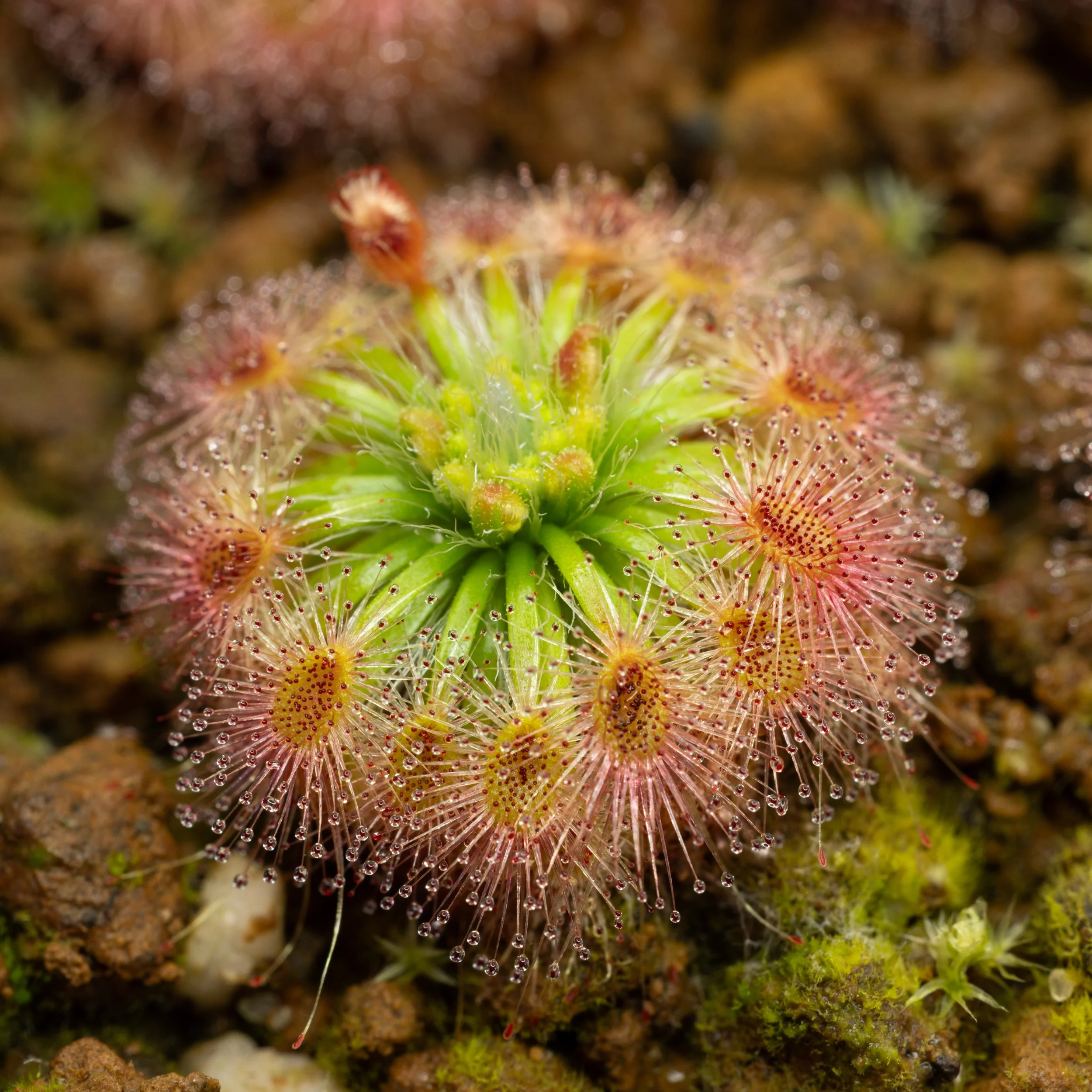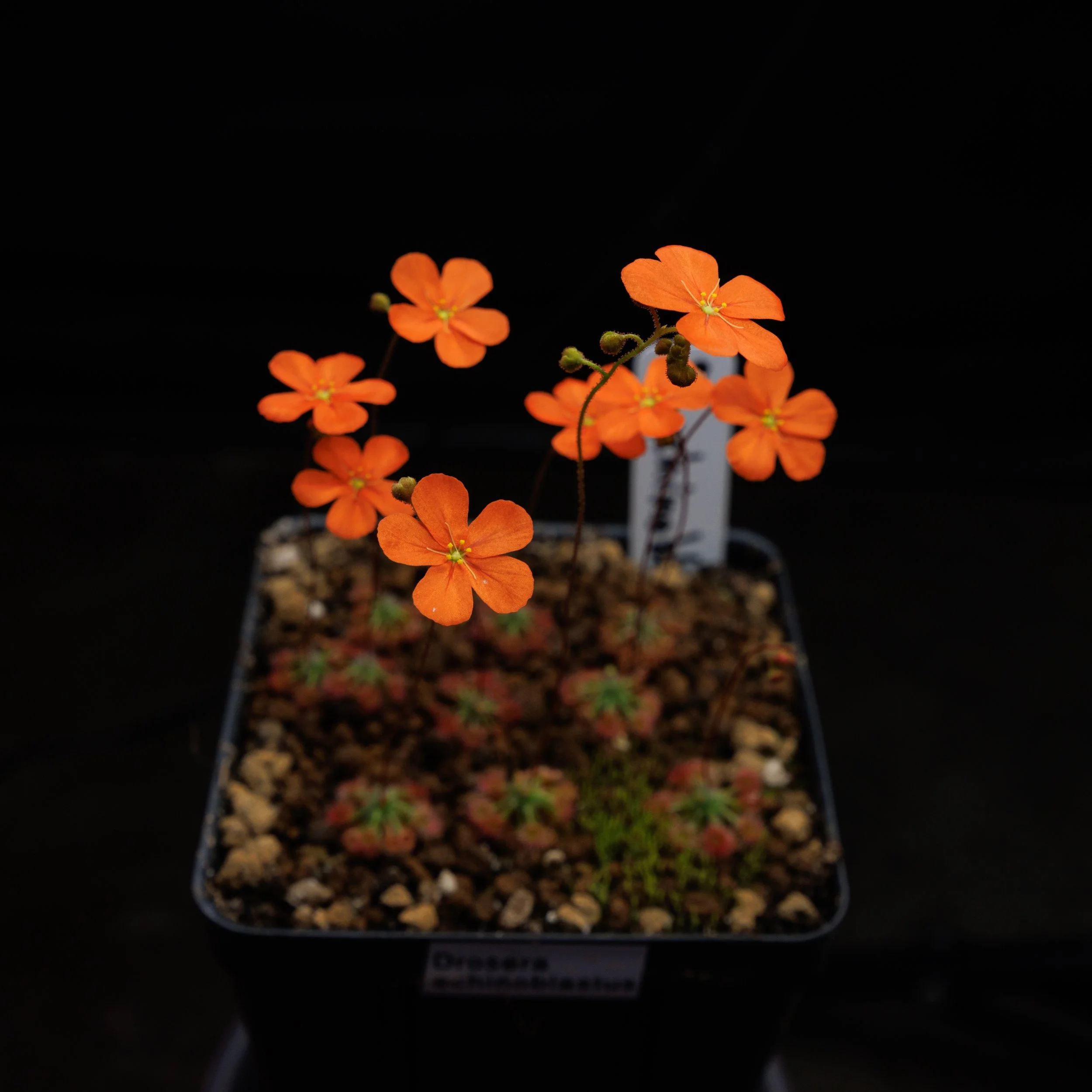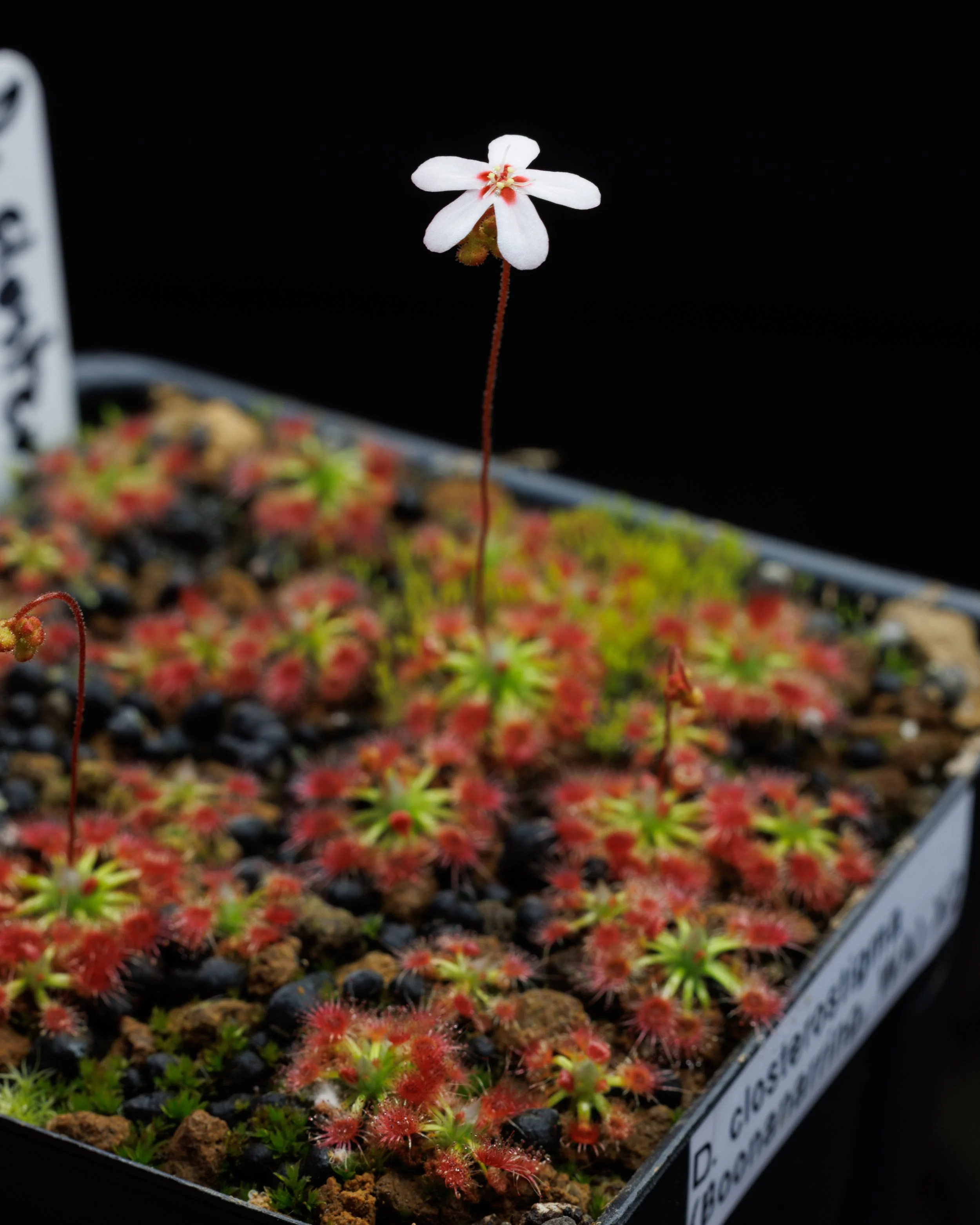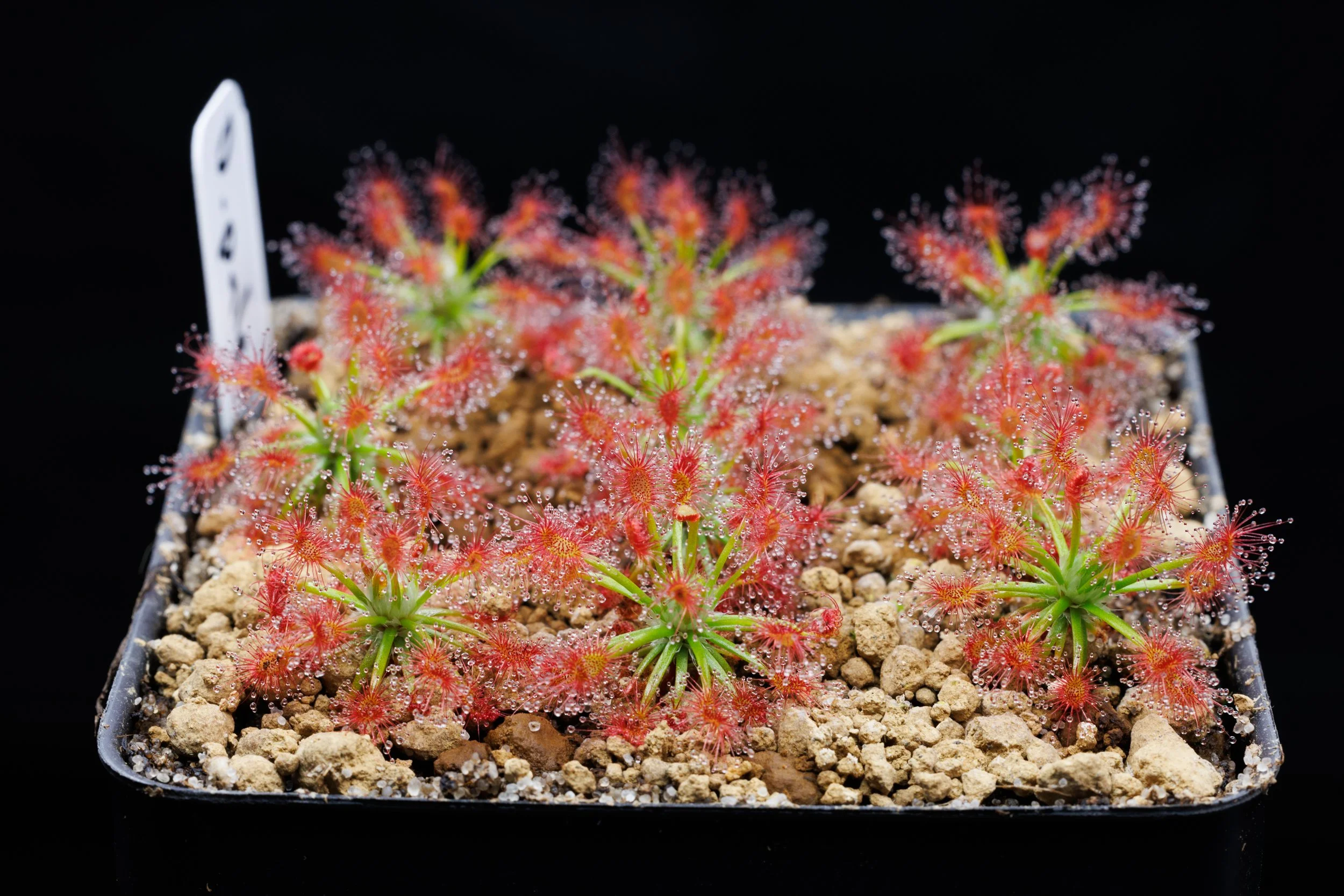Pygmy Sundew (Drosera) Cultivation




















General Info:
Pygmy Sundews (Drosera subgenus Bryastrum) are beautiful, miniature carnivorous plants that are easy to grow and propagate. Their sticky tentacles capture small insect prey, curl towards the center of the leaf blade, then the leaf will secrete digestive enzymes and absorb the essential nutrients. Most species are native to Southwestern Australia and live in a Mediterranean-type climate with cool, rainy winters and hot, dry summers (overlapping with Tuberous Sundews). There are roughly 50 different species in a variety of differently shaped rosettes, but exceptional diversity is in the flowers.
The plants typically grow a circular arrangement of leaves between around 3/8” to 2” in diameter depending on species. Some are flat, geometric rosettes, while others grow a short vertical stem with leaves that form a ball, reminiscent of a palm tree shape. Tuberous sundews can have flowers ranging in colors from orange, purple, pink, white, red, yellow, and many in between. Some flowers have dramatic black centers, while others have a red spot at the base of the petal. These flowers can be tiny (~2 mm diameter) to relatively huge compared to the plant (>1”/25mm).
A unique feature of Pygmy Sundews is their formation of tiny buds called “gemmae” (see photos above). These gemmae can detach from the plant when ripe and will rapidly grow into a new clone of the mother plant. Each plant can produce between around 10-200 gemmae that can be hemi-spheric or disk-shaped in a tight geometric arrangement in the center of the plant. Each gemma is around 1mm long and will grow much faster than seed since it is already vegetative tissue. When placed on moist soil, it will first send out a root, then follow with its first carnivorous leaves. Within a few months, they can be flowering sized plants. Gemmae are produced in response to natural daylight hours, typically around October - November.
Pygmy Sundews will grow great outdoors in any climate that stays above freezing, though extreme heat can cause them to stop growth until temperatures decrease. Most species can be grown together in similar conditions, however some are more tolerant of heat or soggy conditions than others. In general, these prefer better drainage and less moisture than subtropical sundews. If well fed and given strong light, they will grow vigorously and be more resilient to different growing conditions. Light is the most important aspect of their care, with good drainage being second (soil that can drain excess water while retaining some moisture). They love to eat and will grow extremely fast when well fed. If indoors, I will feed them insect powder that I carefully apply with a toothpick to the dewy leaves.
Planting Gemmae:
Prepare a pot with appropriate soil (an easy mix is 60% perlite/sand: 40% peat, some species like a lot of sand and good drainage) and moisten. Deep pots are ideal (minimum 3-4” depth, ideally 5-8”) for the long roots and to ensure good drainage.
Gently place the gemmae on the surface of the pot using small forceps or a toothpick.
Spritz with distilled water to ensure good contact with the soil, then cover with a plastic bag. They do not require high humidity if they can stay consistently moist on the soil, but the bag method is easier for most people.
Put under strong light (avoid direct sun due to the heat) and wait 1-2 weeks for the gemmae to sprout. After they have a few leaves, you can cut off the corners of the bag to allow some airflow. Then continue to acclimate them to lower humidity over the next week or two and remove the bag.
Cultivation:
Climate: Mediterranean (SW Australia). 40-100F, low to moderate humidity.
Light: Part to Full Sun or 20W per sq ft LED light. Pygmy sundews love bright light.
Water: Distilled or Reverse Osmosis water. Sitting in 0.5”-1” of water using tray method. The tray can dry out temporarily as long as the soil stays moist.
Soil: 40% Peat: 60% Perlite/Sand is a good general mix. Some species prefer even better drainage so I use a lower percentage of peat and more perlite/akadama/kanuma/sand.
Feeding: Outdoor plants will typically catch enough food on their own. For indoor plants, feed leaves with Insect Powder at least every month or so (I usually try to feed every 1-2 weeks). I use a moistened toothpick to pick up dry powder, then gently stick it to the tiny tentacles. Only feed an amount that the tentacles can grab with their dew, do not dump powder onto the leaves or plant.
Notes:
These are pygmy sundews! They will generally grow to 0.5”-2” in diameter. Some species are a bit larger, and some like D. scorpioides can develop tall stems over 6” tall.
Feed them light insect powder every few weeks for optimal growth if grown indoors. Only feed fully developed leaves, and feed around 25%-50% of the total leaves each time. I used to feed them a fish food slurry, but have now started applying fish food/insect powder directly to the tentacles. This doesn’t feed as heavily each time but is less messy and prevents overfeeding.
If the temperature is very hot in summer, they might develop white hairs (stipules) in the center of the plant and stop growing. Just wait for temperatures to decrease and they will start growing again. It can help to give them more shade when it is extremely hot.
If the daylight shortens in fall, they will develop “gemmae” which are tiny buds that can detach from the plant and rapidly grow into another plant. Try wiggling them free and planting them on the surface of moist soil.
Pygmies have very long, thin roots so try to give them tall pots. The taller the pot, the deeper the water tray should be. Pots over 4” tall are good, while 5-8” depth is ideal for most species (but not essential).
The long tentacles on pygmy sundews will responds extremely quickly to food. Some species will fully curl in less than a minute. This video is in 10x speed but you can definitely see it feed with your eyes.